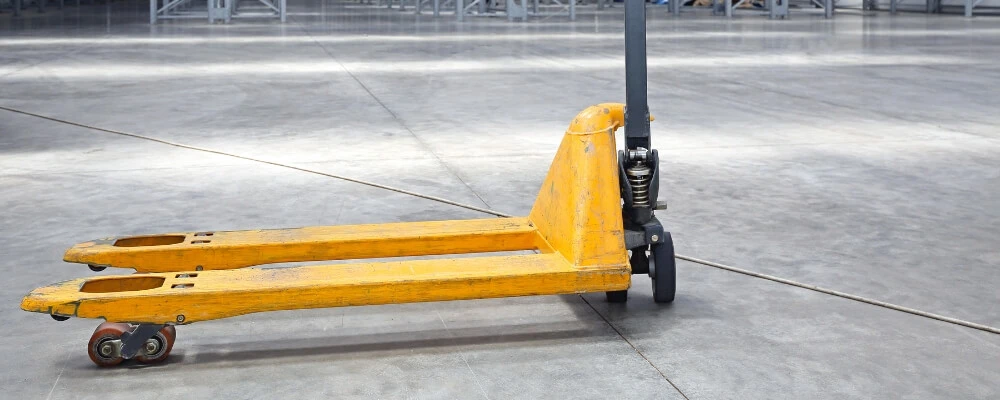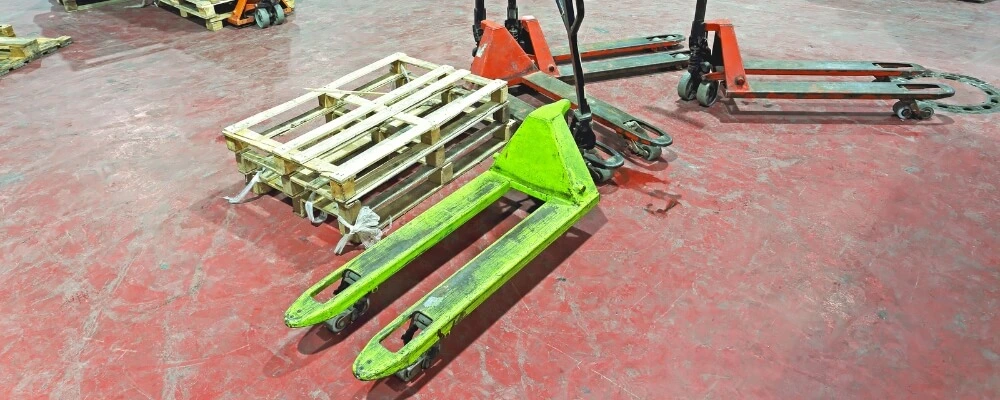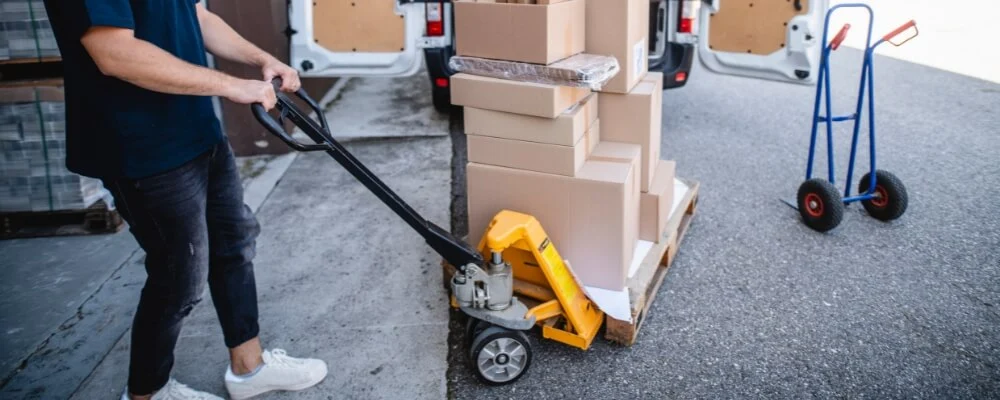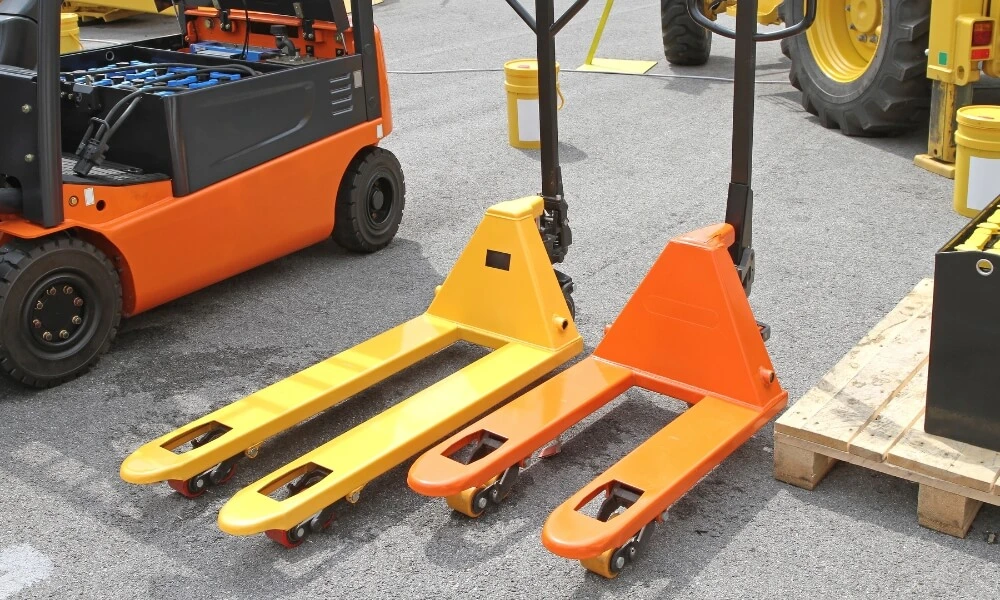In the intricate maze of modern warehousing and logistics, pallet jacks emerge as the unsung heroes, effortlessly bridging the gap between storage and transportation. These seemingly simple tools play a pivotal role in ensuring that goods are moved efficiently, whether it’s from a delivery truck to a storage rack or from one end of a warehouse to another. But, as with any equipment, their convenience is accompanied by a set of safety concerns.
A lapse in proper handling can lead to accidents, some of which can be severe. Thus, it becomes imperative for operators and warehouse managers alike to be well-versed in the safety protocols associated with these devices.
In this blog, we will journey through the 10 cardinal safety rules and the potential hazards tied to pallet jack operations, aiming to equip readers with the knowledge to harness their benefits while safeguarding against potential pitfalls.
What is Pallet Jack?
A pallet jack, also known as a pallet truck, is a manual or powered tool used primarily in warehouses, distribution centers, and manufacturing facilities to lift and transport palletized goods over short distances. It is designed to slide under a pallet, allowing the forks to go into the openings of the pallet. Once the pallet is securely in place on the forks, the operator can lift it off the ground and move it to the desired location.
Components
- Forks: These are the two long, flat extensions that slide under the pallet. They are spaced appropriately to fit the standard openings of most pallets.
- Handle: This is used to steer the pallet jack and often contains the controls for lifting and lowering the forks.
- Hydraulic System: In manual pallet jacks, a hydraulic system allows the operator to pump the handle to raise the forks and the pallet off the ground. In electric or powered versions, this system is operated with the push of a button.
- Wheels: Typically, there are two larger wheels at the front (near the forks) and two smaller swivel casters at the back. This design allows for easy maneuverability.
Uses
- Transporting Goods: The primary use of a pallet jack is to move goods that are stacked on pallets. This is especially useful in settings like warehouses where goods are frequently received, stored, and shipped.
- Loading and Unloading: Pallet jacks are often used to load and unload trucks. They can quickly move goods from the loading dock to their designated storage spot or vice versa.
- Stock Replenishment: In retail settings, pallet jacks can be used to move stock from storage areas to the sales floor.
- Space Optimization: In storage facilities, pallet jacks help in arranging and rearranging pallets to optimize space.
- Safe Handling: Moving heavy pallets by hand can be risky. Pallet jacks provide a safer alternative, reducing the risk of injuries associated with lifting and carrying heavy loads.
In addition to manual pallet jacks, there are also electric or motorized versions that can lift heavier loads and are easier to operate over longer distances. These powered pallet jacks often come with additional safety features and can significantly increase efficiency in larger warehouses or facilities.

Potential Hazards Associated With Pallet Jack
Using pallet jacks in a warehouse or industrial setting can be efficient, but it also comes with potential hazards. It’s important to be aware of these hazards and take appropriate safety precautions to prevent accidents and injuries. Some potential hazards associated with pallet jacks include:
- Tripping: A poorly parked pallet jack can be a tripping hazard for workers.
- Overloading: Exceeding the weight limit can cause the pallet jack to malfunction or tip over.
- Pinching or Crushing: Fingers or feet can get caught between the pallet jack and other objects, leading to injuries.
- Slips and Falls: Spills or wet surfaces can make it slippery, increasing the risk of falls when pushing or pulling the pallet jack.
- Strains and Sprains: Improper lifting techniques can lead to muscle strains or sprains.
- Collisions: Moving too fast or not paying attention can lead to collisions with other objects or people.
- Malfunctions: A poorly maintained pallet jack can malfunction, leading to potential accidents.
- Tipping Over: If the load is not balanced properly, the pallet jack can tip over.
- Rolling Away: On an incline, a pallet jack can roll away if not secured properly.
- Exposure to Chemicals: If transporting hazardous materials, there’s a risk of exposure if the materials spill.
10 Essential Pallet Jack Safety Rules
Pallet jacks, also known as pallet trucks, are commonly used in warehouses and other settings to move heavy loads. While they are invaluable tools, they can also pose safety risks if not used correctly. Here are 10 essential safety rules and potential hazards associated with pallet jacks:

1. Proper Training
Operating a pallet jack isn’t as simple as it might seem. It requires a specific set of skills and knowledge to ensure both the safety of the operator and those around them. Proper training is crucial. This training should encompass both theoretical knowledge about the pallet jack’s operation, its parts, and safety protocols, as well as hands-on experience under the supervision of a trained professional. This ensures that the operator is familiar with the equipment and can handle it confidently in various situations.
2. Inspect Before Use
Just like any other piece of equipment, a pallet jack can wear out or get damaged over time. Before every use, it’s essential to conduct a thorough inspection. This involves checking the wheels for any signs of wear or damage, ensuring the handle is secure and functional, and verifying that the hydraulic system is working correctly without any leaks. A well-maintained pallet jack not only operates more efficiently but also reduces the risk of accidents.
3. Load Properly
The way goods are loaded onto a pallet jack can significantly impact its stability and ease of operation. It’s vital to ensure that the load is evenly distributed across the pallet. An uneven load can make the pallet jack unstable and increase the risk of tipping. Additionally, every pallet jack has a weight limit. Overloading can strain the equipment, leading to malfunctions or breakage.
4. Use Proper Lifting Techniques
While pallet jacks are designed to carry heavy loads, there might be instances where manual lifting is required, such as adjusting the position of a pallet. In such cases, it’s crucial to use proper lifting techniques. This means bending at the knees, keeping the back straight, and lifting with the legs rather than the back. Twisting the body while lifting can lead to severe injuries, so it’s essential to avoid such movements.
5. Stay Alert
Warehouses and storage areas can be bustling with activity. When operating a pallet jack, it’s crucial to remain vigilant and aware of the surroundings. This includes watching out for other workers, being cautious of obstacles on the floor, and being mindful of uneven surfaces that could destabilize the pallet jack.
6. Maintain a Clear Path
Before moving a loaded pallet jack, it’s essential to ensure that the intended path is clear of any obstacles. This might involve removing stray objects, ensuring that other equipment or workers aren’t in the way, and verifying that there are no spills that could make the floor slippery. A clear path ensures smooth movement and reduces the risk of collisions or accidents.
7. Use Appropriate Speeds
Speed can be a significant factor in accidents. Rushing with a loaded pallet jack can lead to loss of control, especially if there’s a sudden need to stop or change direction. It’s always safer to move at a controlled speed, ensuring that the operator has ample time to react to any unforeseen situations.

8. Park Safely
When a pallet jack isn’t in use, it’s essential to ensure that it’s parked safely. This means choosing a designated area where it won’t obstruct pathways or pose a tripping hazard. Proper parking also involves lowering the forks to the ground to ensure stability.
9. Maintain Regularly
Like all equipment, pallet jacks require regular maintenance to function optimally. This isn’t just about efficiency but also safety. Regular checks can identify potential issues like hydraulic leaks, worn-out wheels, or other malfunctions. Addressing these issues promptly can prevent accidents and extend the lifespan of the pallet jack.
10. Use in Designated Areas
Not all areas are suitable for pallet jack operation. Some surfaces, like slopes, can increase the risk of the pallet jack rolling away or tipping over. Similarly, areas with heavy foot traffic can increase the risk of collisions. It’s essential to use the pallet jack only in areas designated for its operation, ensuring the safety of both the operator and those around them.
Conclusion
In conclusion, while pallet jacks are integral to the smooth functioning of warehouses and logistics operations, their use is not without risks. By adhering to essential safety rules and being aware of potential hazards, operators can ensure a safer and more productive environment. It’s a balance of efficiency and caution, where knowledge and vigilance play crucial roles.
As we navigate the complexities of warehousing, let’s remember that safety is not just a guideline but a commitment to ourselves and our colleagues. Equip, educate, and ensure safety – because every accident prevented is a step closer to a flawless operational rhythm.

